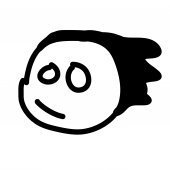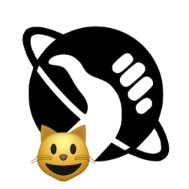-
Posts
2,003 -
Joined
-
Last visited
About Ben

Profile Information
-
Gender
Male
-
Location
: Nottingham, England
-
Interests
Computers, music, films, photography.
-
Member Title
Fully-breaded Cat
Recent Profile Visitors
-
 Polygonius reacted to a post in a topic:
Size file brush and styles
Polygonius reacted to a post in a topic:
Size file brush and styles
-
 MikeTO reacted to a post in a topic:
"Snap to Shape Key Points" and "Snap to Object Geometry" issues
MikeTO reacted to a post in a topic:
"Snap to Shape Key Points" and "Snap to Object Geometry" issues
-
This is what the Point Transform Tool is for. You can drag the vertex point on the blue star and snap it to the geometry of the other object. With the Move Tool - snapping bounding boxes snaps to the visible limits of the other object, but it will snap the selection box of the object being moved. Initially that will be the base box, but you can cycle boxes to get the tight bounds if the base box and tight bounds are different.
-
That appears to be related to a change in Blend Mode type on some object. Can you give any detail as to what you might have changed that affected a Blend Mode? Thanks.
-
 Ezbaze reacted to a post in a topic:
Boolean operations with letters do not work in Affinity Designer 2.0.3!
Ezbaze reacted to a post in a topic:
Boolean operations with letters do not work in Affinity Designer 2.0.3!
-
 Ben reacted to a post in a topic:
Line (Stroke) Width Tool
Ben reacted to a post in a topic:
Line (Stroke) Width Tool
-
 Ben reacted to a post in a topic:
Line (Stroke) Width Tool
Ben reacted to a post in a topic:
Line (Stroke) Width Tool
-
 EricP reacted to a post in a topic:
Spiral Tool
EricP reacted to a post in a topic:
Spiral Tool
-
 lepr reacted to a post in a topic:
Spiral Tool
lepr reacted to a post in a topic:
Spiral Tool
-
 Sean P reacted to a post in a topic:
Spiral Tool
Sean P reacted to a post in a topic:
Spiral Tool
-
 Patrick Connor reacted to a post in a topic:
Spiral Tool
Patrick Connor reacted to a post in a topic:
Spiral Tool
-

Spiral Tool
Ben replied to Ash's topic in [ARCHIVE] 2.5, 2.4, 2.3, 2.2 & 2.1 Features and Improvements
He came up with that example, because that's what I gave him in way of an explanation. When using the cusped version, the spiral is formed from straight lines. The partial turn in this case is a percentage of the distance along these straight lines for a single 'turn'. To express this as an angle about a notional centre is less meaningful when the geometry is not an arc. Using an angle would result in non-linear interpolation of the straight line segments. Note, a 'turn' is a complete lap around, not a segment or arc. Since arc angles (or more accurately, the circle divisor angle) can be arbitrary, a turn is determined as being independent of the arc angle for simplicity. So - you can specify a spiral of 2 turns (a notional rotation of 720 degrees) but then set the arc angle to whatever value gives you the visual result you want. -
 Ben reacted to a post in a topic:
How To Reset The Bounding Box In Designer...
Ben reacted to a post in a topic:
How To Reset The Bounding Box In Designer...
-
 mark117h reacted to a post in a topic:
Spiral Tool
mark117h reacted to a post in a topic:
Spiral Tool
-
 Rudolphus reacted to a post in a topic:
Spiral Tool
Rudolphus reacted to a post in a topic:
Spiral Tool
-
 Rudolphus reacted to a post in a topic:
Spiral Tool
Rudolphus reacted to a post in a topic:
Spiral Tool
-

Spiral Tool
Ben replied to Ash's topic in [ARCHIVE] 2.5, 2.4, 2.3, 2.2 & 2.1 Features and Improvements
Yes, because it is the only curved spiral that finishes in the centre of the shape - all other curved spirals have a non-centred end. The plotted one achieves this (currently) at the expense of it using straight lines to link the procedurally placed points. -

Spiral Tool
Ben replied to Ash's topic in [ARCHIVE] 2.5, 2.4, 2.3, 2.2 & 2.1 Features and Improvements
I can look into on-canvas controls, but not all values/properties can be easily represented with a control point. -

Spiral Tool
Ben replied to Ash's topic in [ARCHIVE] 2.5, 2.4, 2.3, 2.2 & 2.1 Features and Improvements
Yes - the construction for a Phi spiral would be fundamentally different to Fibonacci. The Fibonacci we build from the centre following the sequence. A Phi spiral would be a constant scaling from the outside. I'll have a think. Actually - try using the Decaying spiral, set "Decay per segment" and use 100-(100/phi) for the Decay value. I could probably add this as a preset. We do have a continuous spiral - it's the plotted one. Each point is correctly placed. Currently it's line segments only (though you can increase that to add accuracy). If I can figure out the maths for correct(ish) curve segments I'll add it. -

export text as PSD without rasterizing
Ben replied to Yoko's topic in Pre-V2 Archive of Desktop Questions (macOS and Windows)
Adobe does not publish the internal workings of their text engine. Without this proprietary knowledge it is almost impossible for us to export editable text to PSD. -

Vector Flood Fill
Ben replied to Ash's topic in [ARCHIVE] 2.5, 2.4, 2.3, 2.2 & 2.1 Features and Improvements
Having played with the Live Paint feature in AI, it does seem to get very confused very quickly. It's sort of OK until you change the geometry a lot, then it doesn't really know where you intended the fill to be. The feature also regroups your layers - so will change any ordering you might have had. Fine, unless your ordering was exposed by occluded fills and strokes. So, our approach doesn't mess with your original layer ordering (apart from if you insert fill layers in-between). Also, we create post-editable fill objects - so when you are done, you can treat them like any other layer. -
 Ben reacted to a post in a topic:
Vector Flood Fill
Ben reacted to a post in a topic:
Vector Flood Fill
-

Vector Flood Fill
Ben replied to Ash's topic in [ARCHIVE] 2.5, 2.4, 2.3, 2.2 & 2.1 Features and Improvements
This is a (welcome) side-effect in some ways. The new objects you created to do the internal fills are like any other curve object. So, the 'click to select and fill' method works on them in exactly the same way. When you click it will find the top most filled object at the mouse position - in this case it happens to be an area fill you made previously. -
 Ben reacted to a post in a topic:
Vector Flood Fill
Ben reacted to a post in a topic:
Vector Flood Fill
-
 Ben reacted to a post in a topic:
Vector Flood Fill
Ben reacted to a post in a topic:
Vector Flood Fill
-
 Ben reacted to a post in a topic:
Boolean operations with letters do not work in Affinity Designer 2.0.3!
Ben reacted to a post in a topic:
Boolean operations with letters do not work in Affinity Designer 2.0.3!
-
 Ben reacted to a post in a topic:
Vector Flood Fill
Ben reacted to a post in a topic:
Vector Flood Fill
-
 Ben reacted to a post in a topic:
Vector Flood Fill
Ben reacted to a post in a topic:
Vector Flood Fill
-

Fonts conversted to curves unable to merge/add
Ben replied to darkcrowgraphics's topic in V2 Bugs found on Windows
This will be fixed in 2.1. -
Yes- different platforms are likely to have subtly different fonts. They may have the same name, but might be produced differently. As I stated before - the specific error with failure to perform the bool op is down to edge case calculations as a result of possibly only one or two curves in the font glyphs. This will be rectified in 2.1.













